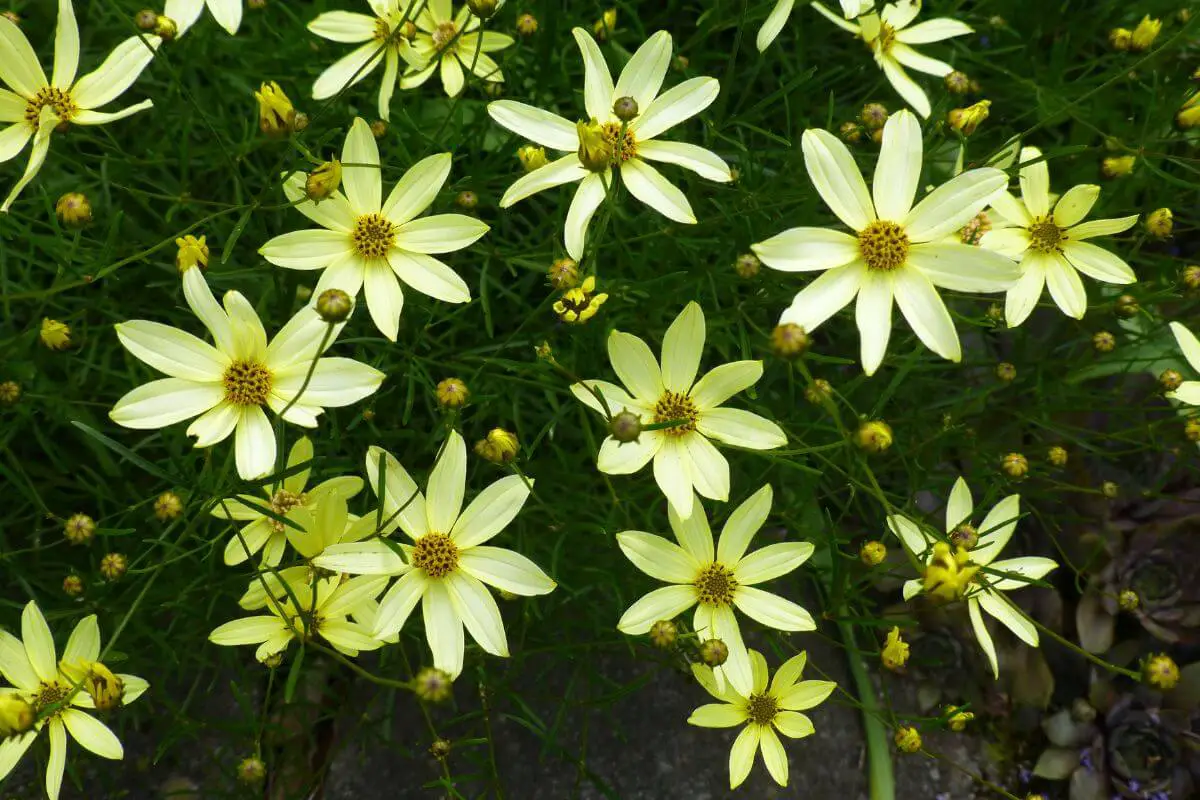Introduction
When it comes to adding vibrant color and beauty to your garden, few perennials can rival the charm of Coreopsis. Coreopsis Zagreb and Coreopsis Moonbeam are two popular varieties that belong to the Coreopsis genus. Both are celebrated for their cheerful blooms and easy-to-care-for nature. In this comparison, we’ll explore the key differences and similarities between Coreopsis Zagreb and Coreopsis Moonbeam to help you decide which one is the ideal perennial for your garden.
Coreopsis Zagreb
Appearance and Features
Coreopsis Zagreb, also known as Threadleaf Coreopsis, is known for its bright and sunny disposition. It features fine, thread-like foliage that serves as a backdrop for its abundant golden-yellow flowers. These daisy-like blossoms have a prominent central disk and bloom profusely from late spring to early summer. Coreopsis Zagreb typically reaches a height of 12 to 18 inches.
Growing Conditions
Zagreb is well-suited for gardens in full sun, where it thrives in well-draining soil. It’s relatively drought-tolerant once established, making it a resilient choice for various climates. Deadheading (removing spent flowers) can encourage continuous blooming.
Maintenance
This variety of Coreopsis is relatively low-maintenance. Aside from deadheading to prolong flowering, occasional pruning and division every few years are recommended to maintain plant vigor.
Coreopsis Moonbeam
Appearance and Features
Coreopsis Moonbeam shares the same cheerful disposition as Zagreb but offers a slightly different color palette. Moonbeam’s pale, lemon-yellow flowers exude a soft and delicate charm. The fine-textured foliage complements the blossoms, creating an airy and graceful appearance. Moonbeam typically reaches a height of 18 to 24 inches.
Growing Conditions
Moonbeam also thrives in full sun and well-drained soil. Its drought tolerance and adaptability make it an excellent choice for various garden settings. Like Zagreb, it benefits from deadheading to encourage prolonged blooming.

Maintenance
Similar to Zagreb, Coreopsis Moonbeam is relatively low-maintenance. Occasional pruning and division can help rejuvenate the plant and ensure long-term health.
Key Differences
- Flower Color: The primary difference between Coreopsis Zagreb and Coreopsis Moonbeam is the flower color. Zagreb boasts bright golden-yellow flowers, while Moonbeam offers pale lemon-yellow blossoms.
- Height: Moonbeam typically grows slightly taller than Zagreb, reaching up to 24 inches in height, whereas Zagreb stays shorter at 12 to 18 inches.
Conclusion
Choosing between Coreopsis Zagreb and Coreopsis Moonbeam depends on your color preferences and the height requirements for your garden. Both varieties share a cheerful disposition, low-maintenance nature, and adaptability to different growing conditions. Whether you opt for the vibrant golden-yellow of Zagreb or the soft lemon-yellow of Moonbeam, you’re sure to enjoy a delightful display of color in your garden from late spring through summer.
FAQs
1. Which variety, Coreopsis Zagreb or Coreopsis Moonbeam, is more suitable for a beginner gardener?
- Both Coreopsis Zagreb and Coreopsis Moonbeam are excellent choices for beginner gardeners. They are low-maintenance perennials that are relatively easy to grow and care for.
2. Do Coreopsis Zagreb and Coreopsis Moonbeam attract pollinators like bees and butterflies to the garden?
- Yes, both varieties of Coreopsis are known for attracting pollinators like bees and butterflies with their colorful and nectar-rich flowers. They can contribute to a thriving and biodiverse garden ecosystem.
3. Are there any specific soil requirements for planting Coreopsis Zagreb or Coreopsis Moonbeam?
- Both varieties prefer well-draining soil. They can tolerate a range of soil types but thrive in soil with good drainage. Amending heavy clay soil with organic matter can improve drainage.
4. What is the best time to plant Coreopsis Zagreb or Coreopsis Moonbeam in the garden?
- The ideal time for planting Coreopsis Zagreb or Coreopsis Moonbeam is in the spring or early summer, after the danger of frost has passed. This allows them to establish themselves before the heat of summer.
5. Do Coreopsis Zagreb and Coreopsis Moonbeam require full sun, or can they tolerate partial shade?
- Both varieties of Coreopsis thrive in full sun, which is typically defined as at least 6 hours of direct sunlight per day. While they can tolerate some partial shade, they will bloom more prolifically in full sun.
6. Can I grow Coreopsis Zagreb and Coreopsis Moonbeam in containers or pots on a patio or balcony?
- Yes, Coreopsis Zagreb and Coreopsis Moonbeam can be grown in containers or pots. Ensure that the containers have good drainage, and use a well-draining potting mix. Place the containers in a location that receives ample sunlight.
7. Are there any specific pests or diseases that I should watch out for when growing Coreopsis Zagreb or Coreopsis Moonbeam?
- Coreopsis plants are generally resistant to most pests and diseases. However, they can sometimes be susceptible to aphids or powdery mildew. Regular monitoring and appropriate pest control measures can help address these issues.
8. Can I use Coreopsis Zagreb and Coreopsis Moonbeam as cut flowers for floral arrangements?
- Yes, both Coreopsis Zagreb and Coreopsis Moonbeam make excellent cut flowers. Their bright and cheerful blossoms can add a pop of color to floral arrangements. When cutting, choose stems with freshly opened flowers for the longest vase life.
9. Do Coreopsis Zagreb and Coreopsis Moonbeam require winter protection in colder climates?
- In colder climates, it’s advisable to provide some winter protection for Coreopsis plants. Applying a layer of mulch around the base of the plants in the late fall can help insulate the roots and protect them from harsh winter conditions.



